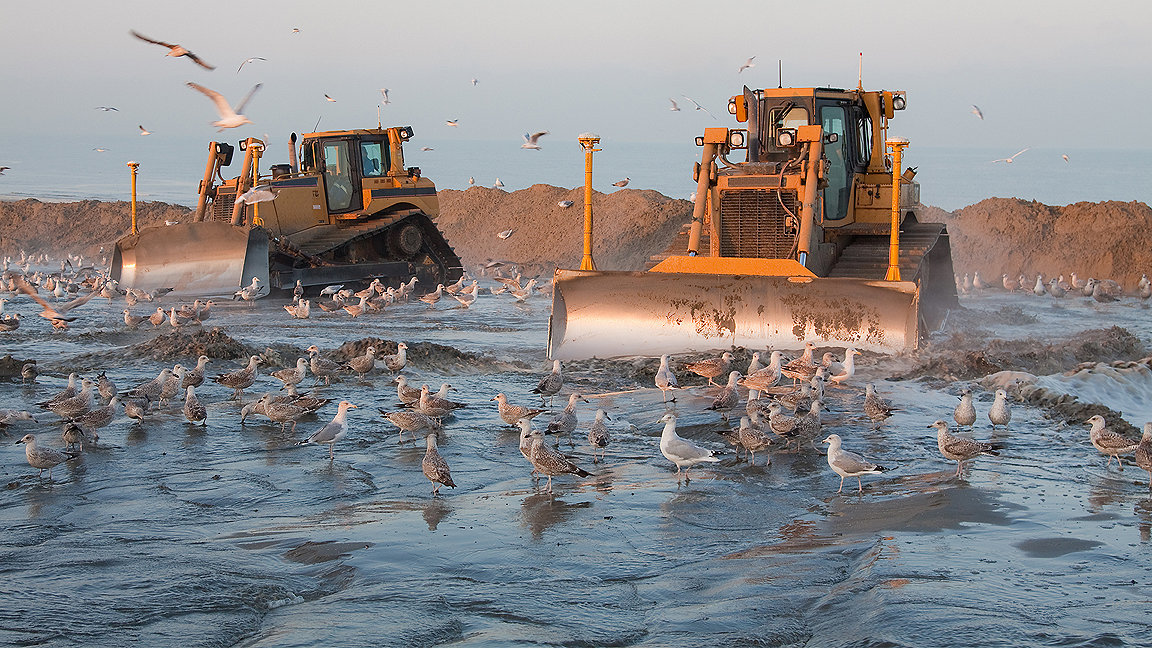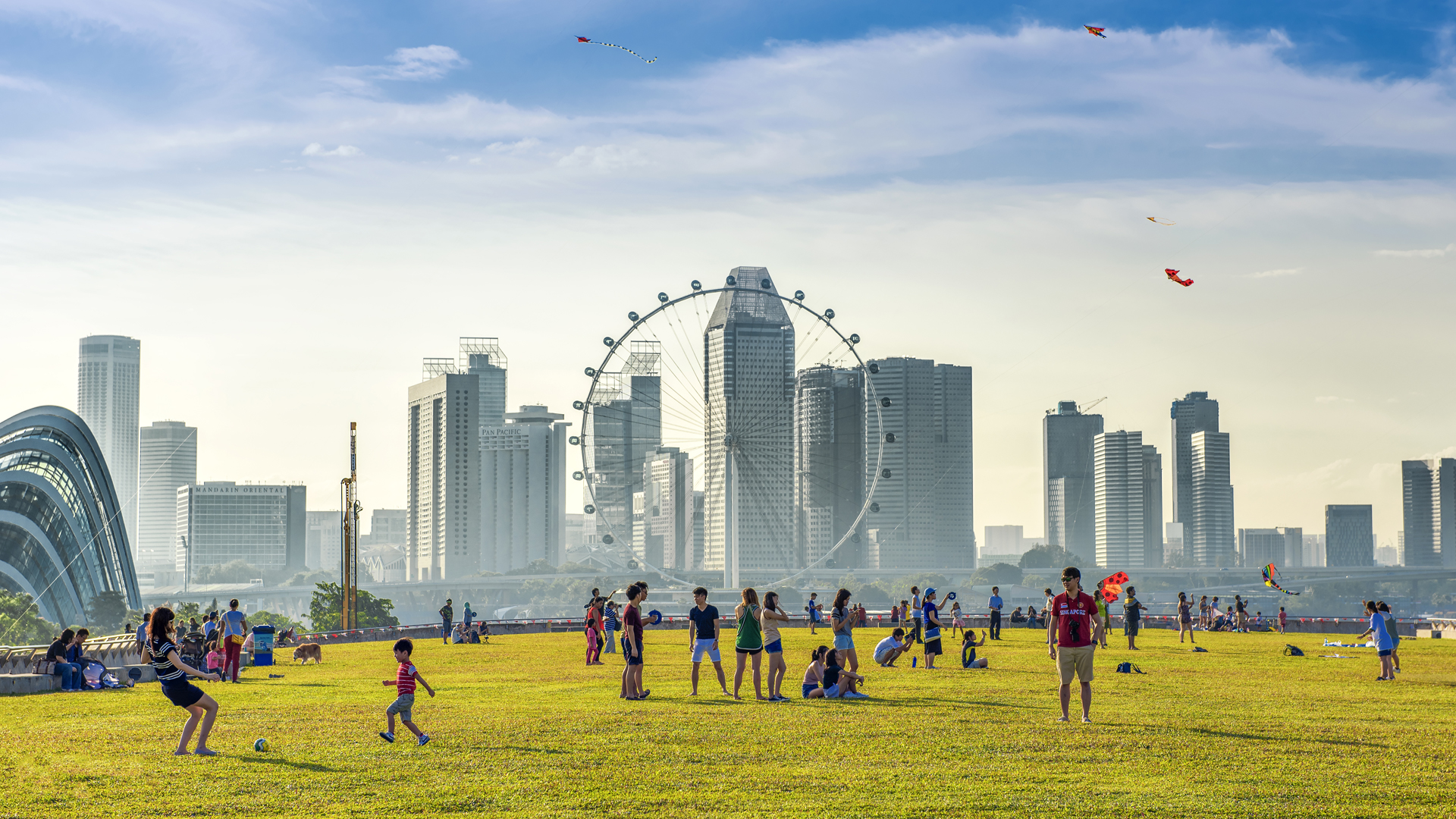
Bulldozers dredging a beach in the Netherlands
In December 2020, Hong Kong’s legislative council approved HK$550m (£50m) for a feasibility study of Lantau Tomorrow Vision, a 17km2 land reclamation scheme proposed just offshore from the city state’s central business district.
Fans, who include Hong Kong CEO Carrie Lam, point to new housing for 1.1m Hong Kong residents, who currently live as densely as any country in the world. Detractors point to the vast cost – at HK$624bn (£57bn), it would drain more than half of Hong Kong’s fiscal reserves. The environmental impact has also been highlighted – two years ago seven local conservation groups cited the threat to endangered marine animals.
More than 40% of Hong Kong residents are against the idea and there have been street protests in opposition. But the bill passed easily, helped by recent expulsions and mass resignation of pro-democracy lawmakers. The new project could be finished by 2034, so land reclamation, it seems, is coming to Hong Kong.
It is not alone. Once the preserve of the Dutch, land reclamation has become integral to city expansion plans across the world. Fast-growing projects showcase the finest in civil and marine engineering, combining the latest construction methods with advanced data science and amphibious technology. But critics question the environmental and social impacts, and challenge their long-term feasibility in the face of rising sea levels.
The two sides may disagree on the merits of global land reclamation, but neither can deny its accelerating speed. Emeka Eleh FRICS, a partner in Ubosi Eleh & Co, an estate surveyor and valuer in Nigeria, estimates that in Lagos alone between 2,000ha and 25,000ha of land reclamation projects are currently under construction. Asia is reclaiming land faster still.
“European dredgers’ efforts are focussed on Asia in counties like Indonesia, where governments support these projects, and the focus is on housing,” says Patrick IJnsen, vice president of the geotechnology division of Dutch marine drilling and piling company Van ’t Hek Group.
In Jakarta, Indonesia work began in 2012 on a $40bn reclamation project to build 17 artificial islands, covering 1,250ha, off the city’s northern coast (although the work has since been halted several times following objections by environmentalists and local fishermen). Individual projects dwarf their predecessors. The Lantau extension will be three times the size of Singapore’s Marina Bay, still one of Asia’s largest reclamation projects, completed in the 2000s.
Drilling and dredging
In most cases, the land used in land reclamation is typically compacted sand dredged from the nearby ocean. Thanks to millennia of erosion, sand on land, too smooth to bind itself to produce a stable structure, is largely useless. But finding the right type of sand might mean sending dredging ships far from the reclamation site, before drilling deep with an array of excavators, cutters and sucker pumps to recover buried sand from deep sea beds.
“Typically, a sand concession is given by the local government,” say IJnsen. Where dredging sites lie far out at sea, it may be unclear who owns the rights, he adds. For countries with large land reclamation plans, securing a reliable supply of sand is crucial. In 2019 Malaysia, Singapore’s biggest source for sea sand, banned exports to its neighbour. “The importance of sand for reclamation can trigger quarrels between countries over resources,” says Piet Dircke, head of resilience and water management at Arcadis, an engineering company based in Amsterdam.
Returning to the reclamation site, ships deposit their dredged loads of sand by the distinctive process of rainbowing, where sand ejected from a funnel traces a wide arc through the air to its destination.
“You are basically spraying it onto the area you want to build upon until you have a big enough pile of sand,” says Rachel Terry, of Van Oord, a Dutch maritime engineering firm, in Rotterdam. GPS-guided bulldozers then shape the piles into the precise dimensions. In cases like Dubai’s Palm, which required fine shapes to be traced to create its distinctive palm shape, this process of shaping is among the most expensive and time-consuming parts of the process.
The deposited sand must then be compacted, squeezing out the water, into a base that can be built upon. Condensing a process that might naturally take 30 years into a few weeks, the process involves a combination of water drainage and pressure, using a range of futuristic-looking machines. Among those sold by Van 't Hek are a giant self-propelled roller, powered by the transfer of water between its internal chambers.
Complex algorithms combine information about the energy used in compacting with the fall in the surface altitude, to provide a measure of the soil’s resistance. This informs how much load the new land will bear and what types of foundations – whose piles may attach to the rock beneath the reclaimed land – will be required for larger buildings. “For a simple house you typically need no pile underneath,” says IJnsen. “From anything from three stories and above, the depth of pile will vary according to the height and weight.”
Finding the right type of sand might mean sending dredging ships far from the reclamation site, before drilling deep with an array of excavators
Photo: Nasa Earth Observatory
Satellite imagery shows the urbanisation of Dubai bewteen 2000 and 2011
Environmental risk
Such an invasive process requires tight regulatory oversight, but this is not always applied.
Eko Atlantic City, in Lagos, Nigeria, is the city’s most ambitious reclamation effort. The 1,000ha land reclamation effort, incorporating an 8.5 km long sea wall, to protect Lagos from coastal erosion and rising sea levels. When complete it will house 250,000 people and a vibrant commercial and financial sector. Already Eko Pearl Towers, a collection of high-rise residential properties, is up to 33 stories in height.
But Eleh says that land reclamation has spilled beyond its agreed boundaries shifting water flows that have led to erosion of surrounding land such as Kuramo Beach on nearby Victoria Island. “The major issue is [developers] don’t follow the plan required of them, especially necessary remediation plans,” he says. And environmental groups claim that dredging sand from the adjacent ocean has left local residents more vulnerable to storm surges. Eleh says the process has exposed fault lines in Nigeria’s development model, where well-connected developers are able to flout environmental or planning rules. “The major issue is political will to do the right thing. People who are well-placed in society have too much influence,” says Eleh.
Turbidity
The process of dredging, moving and depositing sand poses additional environmental risks. As anyone who has tried snorkelling after a storm will testify, disturbing the sea bed even a little throws up a load of fine sand that takes a long time to settle. This may settle on vegetation, screening it from the sun’s rays and preventing photosynthesis, disrupting the local ecology.
“You create a lot of fine sand in the water column, that can end up suffocating coral or marine life,” says Terry.
Where fish seek new feeding grounds or are otherwise displaced, reclamation has an impact on local industries. In Jakarta, local fishing communities started legal procedures against land reclamation efforts in 2015, arguing these deprived them of access to their fishing grounds in the bay and the open sea.
Marthin Hadiwinata, of the Indonesia Traditional Fisherfolk’s Union in Jakarta says that pollution and particulates in the water dispersed fish from rich fishing grounds near the coast to locations further off shore. Fishermen were forced to make longer journeys – significantly increasing their petrol costs – to lower yielding waters, already struggling with high levels of pollution from Jakarta’s 13 rivers, making their businesses unprofitable.
“Where once they would fish easily 300 metres from the coast, now many are having to go 2km out, and their catch is smaller,” he says.
Research by Indonesia’s Ministry of Maritime Affairs and Fishery in 2016 estimated the annual cost to local fisherman at IDR 137.5bn (£8.1m). Hadiwinata says that incomes of many fishermen have fallen by two-thirds, with some taking out punitive high interest loans to survive with local loan sharks. Following the election of a new Jakarta governor, the permits to develop 13 of the 17 islands were revoked in 2018, although previous similar suspensions have been overturned.
Going up
Rising sea levels add to the complexity. Part of Jakarta’s reclamation effort involves constructing outer sea walls to protect the city from its rapid subsidence and the growing threat of rising sea levels.
The city is sinking quicker than any on earth: its northern stretch has sunk 2.5m in 10 years and many areas continue to sink by more than 25cm a year, double the global average for coastal megacities. The cause is over-use of groundwater by the city’s fast-expanding population for drinking, bathing and other uses (when the water is extracted the land around it compacts, sinking). Piped water is unavailable or unreliable across much of the city, and there are few rules governing how and by whom groundwater can be extracted.
Photo: Nasa Earth Observatory
Satellite imagery shows the effects of rising sea levels in Jakarta from 1990 to 2019
Where it works
Where social and environmental considerations can be accommodated by land reclamation projects, the solutions throw up some useful ancillary benefits. That’s been the case for the Dutch coastal town of Katwijk.
By the 2000s, Katwijk’s flood defences were far out of date. The main flood wall was so old that much of the town had now grown out beyond it towards the sea. “Part of the population lived between the dyke and the sea, and the dyke was too low; a major disaster could breach it,” says Katwijk’s mayor Cornelis Visser.
A national flood relief fund launched in 2000 promised resources to build a new wall, but a conventional coastal dyke was out of the question. The town had a vibrant tourist industry, and a rich ecological environment, with European Union environmental protection extended to the beach areas north and south of the town. Residents, in particular hotels and businesses whose commerce relied in part on views from the town’s coastal boulevard, objected to a hard concrete wall obscuring their view and use of the beach.
In 2015, the town constructed a €46m, 1km-long dune, sloping on one side gradually out to sea over several hundred metres, and on the other up and over a concrete flood wall and then an underground car park.
The dune design limited environmental damage from construction. “There was no deep dredging or installing concrete walls. The sea stayed clean and the sand was mined from the sea bed nearby,” says Piet Dircke, leader in resilience and water management for Arcadis, in Amersfoot, The Netherlands, which built the structure. Containing 663 parking spaces, the car park took cars out of the town centre, reducing congestion and pollution. Weaved into the wider flood protection project, its build costs stayed low.
In contrast to traditional concrete flood defences, the gently sloping dune provided a living shoreline with a range of marine habitats provided under low and high tides, hosting a range of flora and fauna. The natural storm protection it provided meant Katwijk no longer needed the five-yearly land reclamation provided by national authorities to much of the Dutch coast (where huge quantities of sand are dredged from the North Sea to replace that washed out to sea by tidal flows).
The solution married the pressing need for improved flood safety with social and economic benefits, says Vesser. “In the long-term it is environmentally friendly, too.” All for a lot less than the cost of the Lantau feasibility plan.
In contrast to traditional concrete flood defences, the gently sloping dune provided a living shoreline with a range of marine habitats


